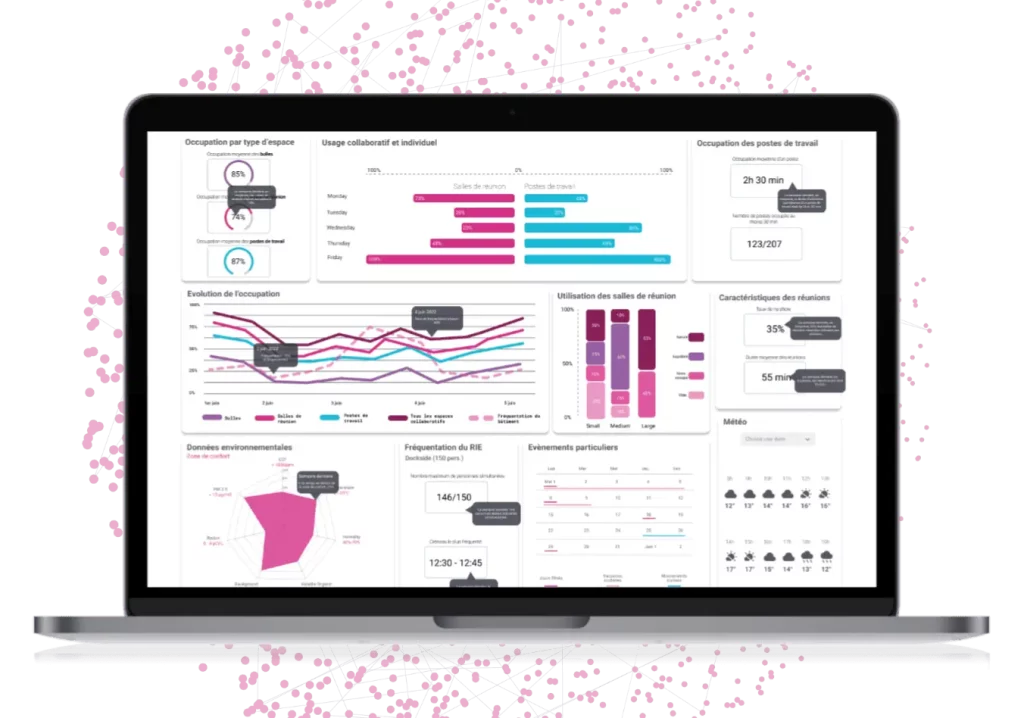What technologies are needed to measure workspace use and occupancy in real time?
In a fast-changing world, work habits and employee needs are evolving. New ways of organizing work and ecological requirements are just some of the challenges facing companies.
At Jooxter, we believe that the best way to anticipate tomorrow's needs is to understand today's behaviors through data.
We set up systems to measure, understand and analyze your workspaces.


Traditional measurement solutions
Measuring workspace occupancy or counting employees on site is nothing new in itself.
For many years, two traditional methods have been widely used:
- Internal survey for qualitative data collection
- Badge for quantitative data collection
Internal survey for qualitative data collection
Internal, anonymous surveys are used to measure key indicators, such as employee well-being and commitment within the organization. They offer the advantage of collecting reliable data at low cost.
Nevertheless, they can be time-consuming to set up, and they impact on the productivity of employees who take time out of their working day to answer the questionnaires.
Internal survey for qualitative data collection
Electronic badges have been used for many years to control access to buildings, and to manage the time and attendance of employees in the workplace.
The data collected gives an idea of office occupancy rates, but this traditional technology has drawbacks that will soon make it obsolete:
- This collection system is not anonymous and does not permanently comply with the RGPD.
- This collection system is neither sufficient nor reliable enough to measure the use of space.
Office occupancy vs. office use
The notion of " spaceutilization" covers two different dimensions:
- How many square metres are used?
- Are the square metres well used?
This measurement, which combines qualitative and quantitative indicators, has now become indispensable for adapting to new standards in the world of work:
- Democratization of teleworking
- Increasing number of workplaces
- Growing need for flexibility on the part of employees

Technological solutions
A number of technological solutions are available on the market to collect the right data.
IP monitoring
IP monitoring measures the occupancy rate of assigned offices, whether they are closed offices or workstations allocated by name to employees in an open space.
While this technology is relatively accurate, its installation cost is high.
It does not allow data to be collected anonymously, yet this point is poorly perceived by employees and contrary to the RGPD.
Beacons or RFid tags
These wireless technologies are versatile and can be used in a wide range of workspaces:
- Dedicated offices
- Flexible offices
- Company restaurants
- Collaborative spaces
- Meeting rooms
Thanks to their Bluetooth connection, beacons will pick up, at regular intervals, the signals emitted by nearby Internet-connected devices such as smartphones or tablets.
RFID tags work in much the same way, except that they use electromagnetic energy to broadcast radio waves to a nearby reader.
These technologies are reliable measurement tools with affordable installation costs, but data anonymization remains the major drawback of these systems.
Wx offers you innovative, reliable solutions that can be easily implemented in your organization, to help you organize and streamline the use of your spaces, while respecting the anonymity of each employee.
Effectively measure the use of your workspaces, while respecting the anonymity of your employees.
The best technologies for measuring occupancy
For every workspace, Jooxter helps you equip your offices with reliable, high-performance solutions that respect employee anonymity and are easy to implement, at costs similar to beacons and RFID tags.

Infrared sensors
Infrared can be used to measure both people's offices and enclosed areas, and in this case only provides used/unused information.
Accelerometers
Accelerometers are placed in the seats, providing information on occupancy rates and the use of unassigned workstations.
Wifi geolocation.
Wifi works by triangulation, and locates devices that have WiFi enabled (such as smartphones). They're not as precise as infrared sensors or accelerometers, but they do give an idea of the number of people present in the whole office.
TOF sensors
This component is called a time-of-flight sensor (ToF sensor). A conventional image sensor behaves like the retina of an eye: it is passive;
On the other hand, a ToF sensor is an active component, since it measures not ambient light, but a kind of "echo" of the light it emits.The complete device consists of two elements:
The time-of-flight sensor itself is a scene illumination system.
These two components work together. It's the measurement of the time it takes for light to return to the sensor that determines its distance from objects.
IR bolometer sensors
A bolometer is an elementary detector. Its principle is simple: it transforms the energy of incident electromagnetic radiation into a heat spot.
Thermal imaging capability enables precise remote temperature measurement.
Sensors can be used to identify and represent objects or people according to their emission temperature.
Making the right decisions workplace
Using all these cutting-edge technologies, information is collected in real time.
They are then presented in dashboards that make it easier to read your statistics and help you make the right decisions.

